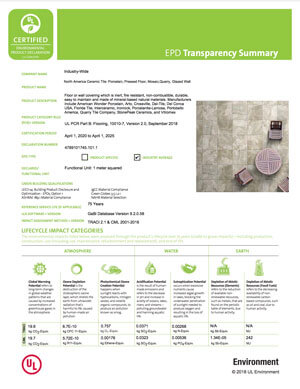Ceramic tile is a floor or wall covering that is fire resistant, inert, durable, noncombustible, easy to clean, and made of mineral based natural materials. This transparency summary is for a UL certified environmental product declaration for the environmental impacts of ceramic tile.
The summary covers the various lifecycle impacts, material content and additional environmental impacts of ceramic tile. It reports on analysis of the complete lifecycle of the material, including raw material extraction and transportation, manufacturing, packaging, use and disposal of the tile at the end of its life. The categories assessed were the impacts of tile on the atmosphere, water and earth. Tile was analyzed for its potential affect on global warming, ozone depletion, photochemical ozone creation, acidification, eutrophication, and depletion of abiotic resources (elements and fossil fuels).
Clay, feldspar, sand, scrap, kaolin, granite, lime and other additives are all material contents of in tile, and it’s typically covered with a glazed and stained surface for finishing texture and protection. Ceramic tile is highly durable and can outlast multiple generations of building occupants. It is often either reused in an existing building or salvaged for use in new buildings. Solid and inert, it is often used in a variety of post-life applications such as roadway paving, clean fill, and providing raw materials for manufacturing new products.
In order to present conservative analysis and forecast for a worst case scenario, this EPD transparency summary has reported on tile’s environmental impacts based on the assumption that 100% of all tile and removal waste was disposed of in a landfill.

